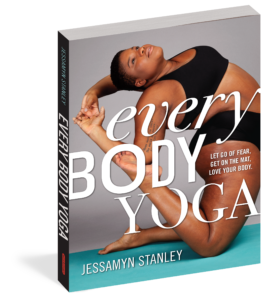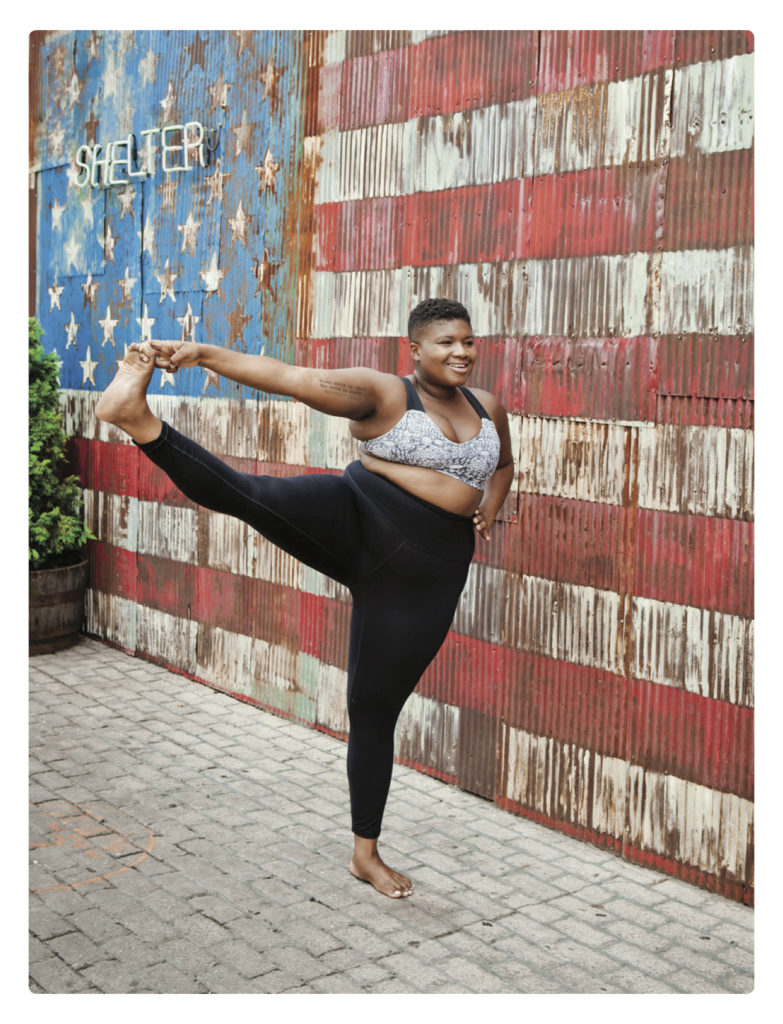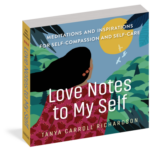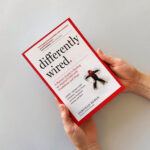Start your week off on the right foot with this excerpt on self-acceptance from Jessamyn Stanley’s Every Body Yoga, on sale now!
Buy the Book
Indiebound | B&N | Amazon | Workman
Self-Acceptance: The Taboo
Accepting our bodies is the most crucial aspect of holistic health and happiness—and a strong yoga practice. But it can be really effing hard to reconcile the realities of our anatomy with the delusions of our mind. I’ve always wanted to be dainty, but I’m genetically burly. My shoulders are broad as all hell—I am truly my father’s daughter. In yoga, it’s really important to understand your body’s actual foundation—shoulders, hips, wrists, and elbows all must be in proper alignment. And if you place your hands and arms too close together because you don’t wish to accept your shoulders’ actual width, you will have jacked-up alignment every time. When I began practicing yoga, I completely misunderstood my shoulder girdle size and found it extremely difficult to hold basic yoga poses like Downward-Facing Dog, High Plank, and Four-Limbed Staff Pose. Basically, it was damn near impossible for me to find a stable foundation in yoga asana because of my inability to accept my body’s natural structure. However, once I found a way to accept my body’s structure, my whole perspective of asana practice shifted for the better.
When I see companies attempting to package and distribute “body positivity,” I always have to fight off rounds of the giggles. I mean, they try to package self-acceptance as something you can purchase at your local shopping center, right next to face masks and laxatives. I think we can all agree that shit doesn’t really work that way. First of all, can we acknowledge for a moment that corporate America is basically the source of body negativity? Think about how much companies profit when you feel shitty about yourself. I mean, if we thought our skin was perfect exactly as it is, would we feel compelled to buy Dove’s latest face cream? If we thought our lips were perfect as they are, would we look twice at Maybelline’s new lip color line?
No, we wouldn’t.
I can only speak for myself, but my early life’s ambition was to embody whatever beauty ideals were being perpetuated by the most popular and loudest voices. And if you don’t fit within their very narrow definition of beauty, you’re expected to change every detail of yourself until you do fit in the definition.
And yeah, this isn’t just an issue for people who call themselves women—men have just as much body dysmorphia as ladies. In some cases, it’s definitely way worse. And when we only let one category of people call all the mental shots, the only way for things to go is badly.
I’ll be damned if there’s a public space we can enter without throwing painful barbs at ourselves and others—whether it’s a middle-aged mom who refuses a slice of chocolate cake because she’s “already too fat,” a teenage girl who deems a fellow Forever 21 shopper “too chunky for that top,” or a barrel-chested guy who hesitates to participate in a 5K because “other people shouldn’t have to see man boobs jiggling around.” All of these words create a toxic language that pollutes the way we see ourselves and those around us.
I’ve never observed a scene where toxic body language is as widespread and generally accepted as within the fitness world. In pursuit of health and well-being, most athletic arenas become festering breeding grounds for negative body language. You would think that the Modern yoga world would be a relatively safe space, free of sizephobia and judgment, but that is far from reality.
Let’s take a look at “Jill,” a thirty-six- year-old mother of two, her body curvier and more “structurally unique” than she remembers it pre-pregnancy. (In my yoga classes, I meet quite a few Jills. Maybe you’re a Jill too.) As Jill stares at her fellow yoga practitioners rolling out their mats before class, she admires their sinewy arms and laser-cut abdomens and immediately begins berating herself for not resembling them. She thinks, “I need to lose at least twenty pounds. How am I going to make it through this yoga class if I don’t look like them?”
By giving voice to this hateful body language, Jill is creating two problems:
First of all, she’s ruining her opportunity for a pleasurable yoga practice. By deciding that her body is somehow unsuitable for yoga, our heroine has poisoned her brain, the one muscle that can truly make or break her potential for a soothing practice. It’s likely that this perfectly capable and strong woman (she gave birth to two children, for crying out loud) will underestimate her abilities and allow the phrase “I can’t” to define her practice.
Second of all, let’s say our heroine decides to share some of her body hate spiel with one of her fellow classmates. Not only has she poisoned her brain with judgment, but she’s also poisoned the mind and mood of her friend. Instead of adding to the positive vibe of her yoga studio, she’s now become an active participant in an unspoken hierarchy where certain bodies matter and others don’t. Without recognizing it, Jill has inadvertently assumed the role of her own oppressor.
At what point would YOU finally say, “I’ve had enough of hating my body”? Accepting our bodies is more than just size acceptance. It’s understanding that beneath these layers of complicated fabric, we’re all basically the same. Imperfect (yet absolutely perfect) humans.
I didn’t understand my body unhappiness for the majority of my life, and I believed what the media told me—I assumed my body was built incorrectly and desperately hoped to wake up one day looking like someone else. Instead of seeking out the core of my dislike, I chose to hide myself behind my clothes, makeup, and hair extensions. I happily took any route I could find to resemble the picture of beauty presented to me in movies, magazines, and TV shows. I know I’m not the only person who has felt this way—we want to be accepted by our peers, and the pursuit of peer acceptance results in a desperate (and ultimately futile) struggle to don someone else’s skin.
If our lives truly revolve around acceptance, why don’t we focus that same amount of energy on SELF-acceptance? So many doctors immediately disregard self-acceptance in favor of facts and figures about scientifically accepted healthy body composition. Sometimes it feels like the entire Western medical profession believes losing weight and maintaining a body size that’s defined as “healthy” is the single route to happiness. I hope I’m not the only person who finds this argument laughable. We all struggle with debilitating emotional boundaries. Bad self-esteem and body shame know no size—they happen to everyone. What makes the difference is how we choose to handle our self-esteem issues and body shame—do we accept them or allow free rein over all our judgments?
Honestly, body discrimination doesn’t end even when you become a yoga teacher. I can’t tell you the number of people who have walked into my yoga classes completely shocked and confused to see me sitting behind the check-in counter. They usually smile curtly and ask if I’m the teacher or merely checking people in. When I cheerfully reply that yes, I’m actually the teacher, I can clearly see their faces flash from “WHAT THE ACTUAL FUCK” to “Dammit, I guess I’m gonna have to pay this fat girl $15 to get a lackluster exercise experience.” It should be no surprise that most people think fat people have no idea how to lead an exercise class. It takes confidence to accept ourselves exactly as we are in the face of people who want us to doubt our abilities. It means realizing that we’re really dealing with fear—we’re afraid of being judged.
Lesson Learned
Fear can take a physical toll. If our bodies are outfitted with a stress storage bin, our hips fit the bill. Every time we feel compelled to flee or fight in our daily lives, our reactions become trapped in our hip joints. By releasing and relaxing our hips on a regular basis, we can unburden ourselves of the emotional weights that make it difficult to move forward and be present in life. If you find that this sequence brings up unexpected emotions, just embrace them. By unburdening your hips of tension you can unburden the space around your heart and allow yourself to be more present, calm, and happy on a daily basis.
 About the Book
About the Book
From the unforgettable teacher Jessamyn Stanley comes Every Body Yoga, a book that breaks all the stereotypes.
It’s a book of inspiration for beginners of all shapes and sizes: If Jessamyn could transcend these emotional and physical barriers, so can we.
It’s a book for readers already doing yoga, looking to refresh their practice or find new ways to stay motivated.
It’s a how-to book: Here are easy-to-follow directions to 50 basic yoga poses and 10 sequences to practice at home, all photographed in full color.
It’s a book that challenges the larger issues of body acceptance and the meaning of beauty.
Most of all, it’s a book that changes the paradigm, showing us that yoga isn’t about how one looks, but how one feels, with yoga sequences like “I Want to Energize My Spirit,” “I Need to Release Fear,” “I Want to Love Myself.”
Jessamyn Stanley, a yogi who breaks all the stereotypes, has built a life as an internationally recognized yoga teacher and award-winning Instagram star by combining a deep understanding for yoga with a willingness to share her personal struggles in a way that touches everyone who comes to know her. Now she brings her body-positive, emotionally uplifting approach to yoga in a book that will help every reader discover the power of yoga and how to weave it seamlessly into his or her life.






No Comments